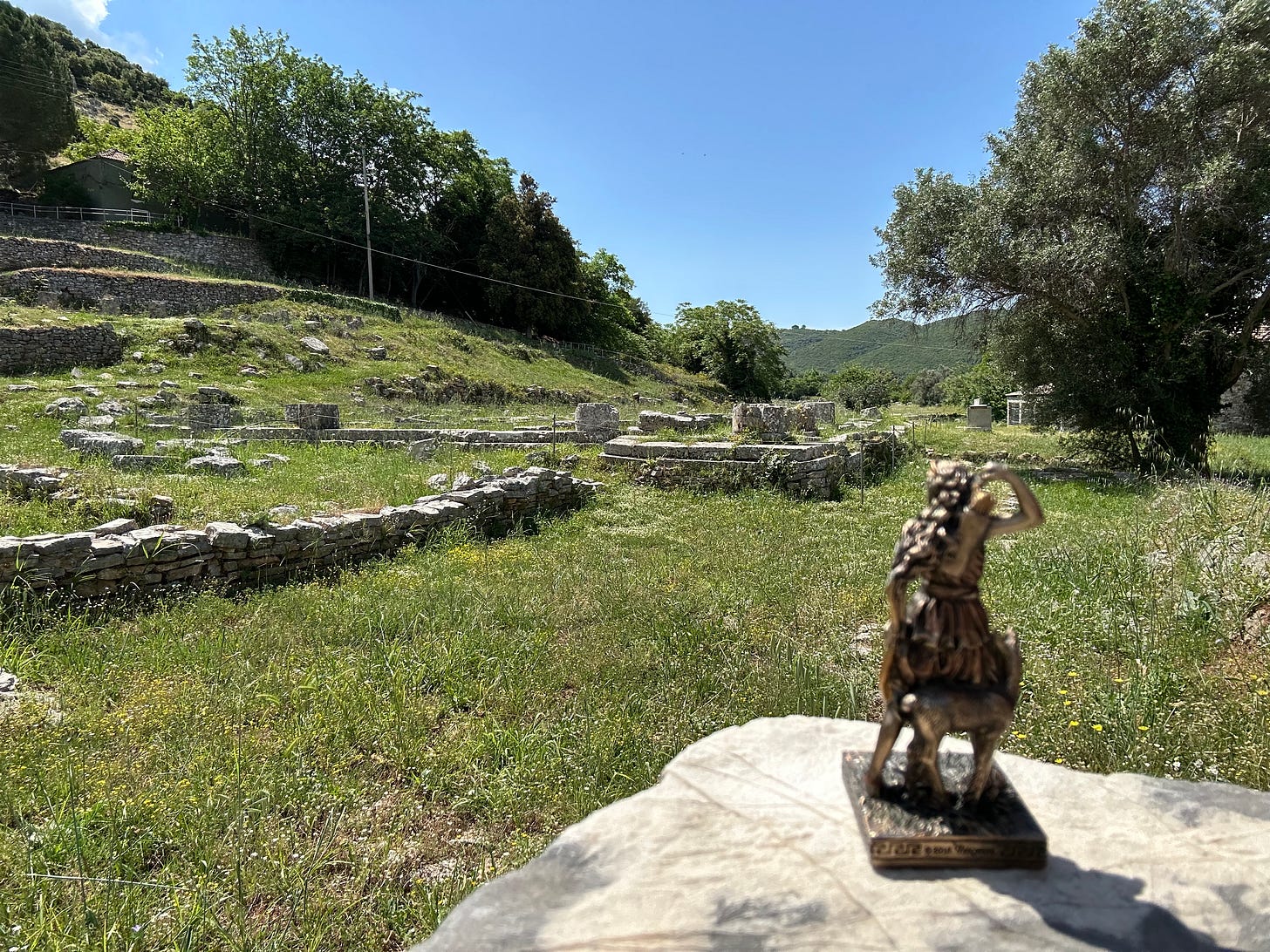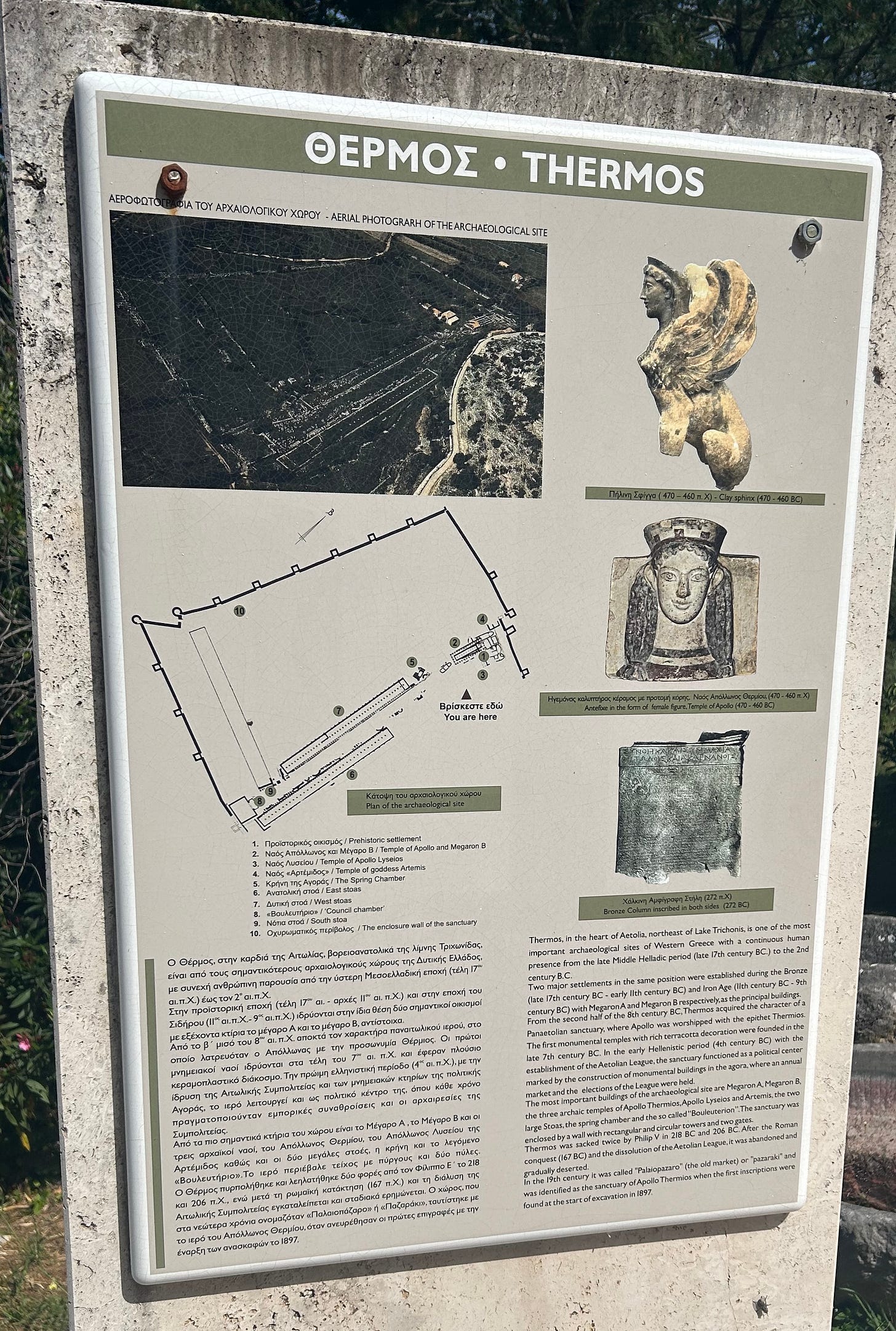We pulled into Thermos on a dry May morning, unsure of what would still be visible. The signage was sparse, the ground sun-bleached and quiet, and there wasn’t a single other person in sight. Which, for us, is ideal.
We weren’t here for Apollo. We were here for Artemis.
There’s plenty written about the Aetolian League and its political machinery, the grand temple of Apollo Thermios, the council chamber, the Hellenistic stoas that framed the agora. That narrative is tidy, civic, masculine. But a quick look at the site plan makes one thing very clear: Artemis wasn’t placed at the centre of that public performance. She stood just beyond it, northeast of the agora, slightly elevated, and facing the Spring Chamber.
Which, frankly, feels exactly right.
Thermos: A Brief History Beneath Our Feet
Thermos, northeast of Lake Trichonis in Aetolia, is one of the most important archaeological sites in Western Greece, with continuous habitation from the late Middle Helladic period (17th century BCE) all the way through to the 2nd century BCE. The earliest remains include Mycenaean structures, Megarons A and B, which likely functioned as ritual and residential buildings during the Late Bronze Age.
By the 8th century BCE, the site had become a pan-Aetolian sanctuary, and in the Archaic period, Apollo Thermios became its dominant cult figure. His temple, built around 630–610 BCE, was one of the first Doric temples in mainland Greece. Over time, Thermos evolved into the religious and political hub of the Aetolian League, with monumental civic construction in the 4th and 3rd centuries BCE, including stoas, fountains, towers, and gates. But that’s the League’s story.
We’re here to write Artemis back into it.
Locating Artemis: Geography, Not Margins
The Temple of Artemis sits just northeast of the agora, outside the formal stoa-lined civic plaza, but still firmly inside the sacred enclosure wall. If you’re looking at the site plan, she’s marked as #4. To her west is the Temple of Apollo Lyseios. South of that is the Spring Chamber. And to her east, a path that likely led to outer towers and gates.
She’s not peripheral. She’s directional.
In Greek sanctuaries, Artemis is often associated with transitional boundaries: the edges of cities, thresholds between civic space and nature, spaces between youth and adulthood. Her temple at Thermos is consistent with this pattern. She isn’t buried in the woods, but she also isn’t participating in the full theatre of the male-dominated agora. She’s watching from the border, connected, but distinct.
Her Sanctuary and Possible Rites
The remains of the Temple of Artemis are simple, limestone foundations measuring roughly 6 × 13 meters, with a pronaos and four Doric columns. There’s no sculpture or architectural ornament surviving in situ, but the placement of the sanctuary suggests active ritual use.
Excavations have uncovered evidence of sacrificial activity, burnt animal bones and ash, around her precinct. These align with ritual behaviours we see in other Artemis sanctuaries, especially those in western and central Greece. Given the proximity to the Sacred Fountain, it’s reasonable to propose that her worship here included rites of purification, possibly connected to young women’s transitions or agricultural cycles.
The Spring Chamber, carved directly into bedrock and later formalized into a more elaborate spring structure, seems to have held both practical and sacred functions. While we can’t say for certain how the fountain was used, its alignment with Artemis’s sanctuary raises some familiar possibilities: ritual washing, votive offerings, or seasonal renewal rites tied to the flow of water and fertility of the land.



Putting Her Back on the Map
Finding Artemis’s temple at Thermos, even in a quiet corner of the sanctuary, unlabelled and largely overlooked, reminded me why I do this work. Why I’ve poured so much time, patience, money, and sometimes frustration into the Artemis Mapping Project. Because she is there. Even if the signage skips over her. Even if Apollo takes up all the space. Even if the stoa gets more attention than her sanctuary.

There was no plaque near her temple. Not even a marker in the grass. Meanwhile, Apollo’s temple had two. But that’s why we go. That’s why I’m putting her name back on the map. I would bet, with confidence, that she was significant here. More significant than the silence suggests.
And there’s something else. Every time we visit a quiet, overlooked site like Thermos, there’s often a single guard or caretaker. In this case, a kind woman came out and gave us a Thermos booklet and thanked us for visiting. But when we said, “We’re here for Artemis,” I saw something shift. A kind of spark. A pause. Maybe it plants something. Maybe it lifts something. Maybe next time, they’ll expect someone to come looking for her. Maybe next time, they’ll remember that she was here. And she still is.
Thank you for walking beside me on these journeys. Your support is what makes it possible for me to keep seeking her, site by site, stone by stone, and to keep saying her name, especially in the places where it’s been forgotten.
If you’re inspired by this work and want to support what we’re building, whether it’s mapping forgotten temples across Greece and Turkey, researching ancient rites, or making goddess-centred education more accessible, please consider supporting this blog, sharing it, or becoming a patron.
You can also purchase my book, She Who Hunts: Artemis, the Goddess Who Changed the World, a heartfelt and scholarly introduction to the Greek Artemis. It’s a great place to begin if you're curious about her history, her many faces, and why she still matters today.
Every offering helps fund fieldwork, content creation, and the long work of restoring her memory, one step at a time.
With strength,
Carla
www.artemisresearchcentre.com




